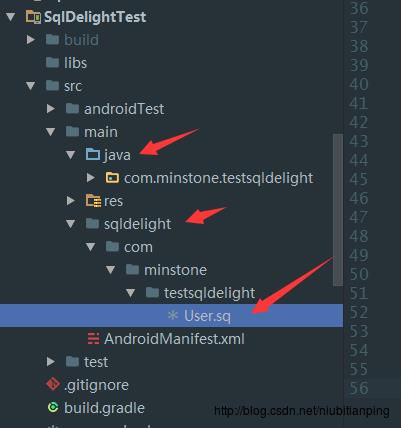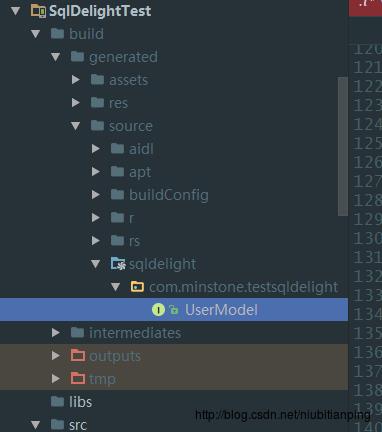Android SqlDelight详解和Demo例子
Posted SkyHandCsdn
tags:
篇首语:本文由小常识网(cha138.com)小编为大家整理,主要介绍了Android SqlDelight详解和Demo例子相关的知识,希望对你有一定的参考价值。
一、简介
SQLDelight 和 SqlBrite 是 Square 公司推出的一个 android 平台数据库解决方案。
在了解这个两个东西前,必须先得有Andorid的Sqlite的知识(SqliteDatabase and SqliteDataHelper), AutoValue
要分清他们两个的功能:
SqlDelight
是用来把Sql语句生成Java对象的SqlBrite
才是Sqlite操作,结合Rxjava进行响应式数据库操作。SqlBrite教程
二、SqlDelight
SqlDelight是从SQL语句来生成JAVA对象。这样的好处是,所有SQL语句都位于同一个位置,通过查看SQL语句可以清楚的了解需要实现的功能和数据库的结构。
SqlDelight添加了对SQL语句的编译时验证、表名字和列名字的代码自动完成功能。让编写SQL语句更加快捷。在编译的时候,根据SQL语句生成Java模型接口和builder来把数据行和Java对象实现转换。
2.1 导包
- 在项目build.gradle的dependencies添加:
classpath 'com.squareup.sqldelight:gradle-plugin:0.6.0'- 在module的build.gralde头部添加apply
apply plugin: 'com.squareup.sqldelight'
重新Sync即可。
2.2 使用
SqlDelight 可以根据建表的 SQL 语句自动生成 Java model interface,interface 的每个方法就是这张表的每一列。
1. 编写sq语句
在main目录创建sqldelight目录,然后按照包名创建目录, main/sqldelight/com/xxx/xxx/sq文件(一定得是正确的目录,不然构建失败)

这里编写创建表和查询的语句;
create table user(
_id INTEGER NOT NULL PRIMARY KEY AUTOINCREMENT,
name TEXT NOT NULL,
age INTEGER NOT NULL
);
-- 其他的语句通过标识符来引用。在生成的 Java 对象中会包含
-- 一个该标识符的常亮引用这个语句。
-- 查询use表,百分号(%)代表零个、一个或多个数字或字符,||连接两个不同的字符串,得到一个新的字符串。
select_by_name: select * from user;2. 生成接口Module
编写完毕sql语句之后,make一下moduel,即可在build/generated/source/sqldelight/包名/看到xxxModule接口文件 (xxx就是你的sq文件的名称)。

可以看到接口大概是这样的。
public interface UserModel {
String TABLE_NAME = "user";
String _ID = "_id";
String NAME = "name";
String AGE = "age";
String CREATE_TABLE = ""
+ "create table user(\\r\\n"
+ " _id INTEGER NOT NULL PRIMARY KEY AUTOINCREMENT,\\r\\n"
+ " name TEXT NOT NULL,\\r\\n"
+ " age INTEGER NOT NULL\\r\\n"
+ ")";
long _id();
@NonNull
String name();
long age();
interface Creator<T extends UserModel> {
T create(long _id, @NonNull String name, long age);
}
final class Mapper<T extends UserModel> implements RowMapper<T> {
private final Factory<T> userModelFactory;
public Mapper(Factory<T> userModelFactory) {
this.userModelFactory = userModelFactory;
}
@Override
public T map(@NonNull Cursor cursor) {
return userModelFactory.creator.create(
cursor.getLong(0),
cursor.getString(1),
cursor.getLong(2)
);
}
}
final class Marshal {
protected final ContentValues contentValues = new ContentValues();
Marshal(@Nullable UserModel copy) {
if (copy != null) {
this._id(copy._id());
this.name(copy.name());
this.age(copy.age());
}
}
public ContentValues asContentValues() {
return contentValues;
}
public Marshal _id(long _id) {
contentValues.put("_id", _id);
return this;
}
public Marshal name(String name) {
contentValues.put("name", name);
return this;
}
public Marshal age(long age) {
contentValues.put("age", age);
return this;
}
}
final class Factory<T extends UserModel> {
public final Creator<T> creator;
public Factory(Creator<T> creator) {
this.creator = creator;
}
/**
* @deprecated Use compiled statements (https://github.com/square/sqldelight#compiled-statements)
*/
@Deprecated
public Marshal marshal() {
return new Marshal(null);
}
/**
* @deprecated Use compiled statements (https://github.com/square/sqldelight#compiled-statements)
*/
@Deprecated
public Marshal marshal(UserModel copy) {
return new Marshal(copy);
}
public SqlDelightStatement select_by_name() {
return new SqlDelightStatement(""
+ "select * from user",
new String[0], Collections.<String>singleton("user"));
}
public Mapper<T> select_by_nameMapper() {
return new Mapper<T>(this);
}
}
}从这个接口可以看到重要的有下面四个类和接口:
Mapper
把 Cursor 映射为 Java 对象Marshal
把 Java 对象转换为 ContentValues,好方便插入数据库接口Creator
里面定义了一个方法create用来创建我们的Model类型(这里用的是泛型T)- Factory
里面包含一个实现了Creator对象的creator,如果有列值需要转换的话还要包括相应的ColumnAdapter,它的构造函数传入Creator和ColumnAdapter这些参数,marshal方法返回Mode的Marshal(通过它的asContentValues获取对应的ContentValues)
3. 定义Bean类
这里利用AtuoValue重写接口,因为SqlDelight生成的接口适合AutoValue无缝接入的,AutoValue的作用的是,自动生成bean代码,AutoValue请点击我。
使用需要导包
//基础AutoValue
apt 'com.google.auto.value:auto-value:1.4-rc3'
provided 'com.google.auto.value:auto-value:1.4-rc3'
//AutoValue的扩展,为每个AutoValue注释对象创建一个简单的Gson TypeAdapterFactory。
//https://github.com/rharter/auto-value-gson
apt 'com.ryanharter.auto.value:auto-value-gson:0.4.6'
provided 'com.ryanharter.auto.value:auto-value-gson:0.4.6'
//AutoValue的扩展,支持Android的Parcelable
apt 'com.ryanharter.auto.value:auto-value-parcel:0.2.5'
// 可选择TypeAdapter支持
compile 'com.ryanharter.auto.value:auto-value-parcel-adapter:0.2.5'
这时候User的bean为
@AutoValue
public abstract class User implements UserModel {
public static final Factory<User> FACTORY = new Factory<>(new Creator<User>() {
@Override
public User create(long _id, @NonNull String name, long age) {
//AutoValue_User 需要先make一下module
return new AutoValue_User(_id,name,age);
}
});
public static final RowMapper<User> SELECT_ALL_MAPPER = FACTORY.select_by_nameMapper();
}4. 使用
然后写一个Activity来测试看看(Sqlite相关知识请百度,点我看教程):
public class MainActivity extends AppCompatActivity {
@Override
protected void onCreate(Bundle savedInstanceState) {
super.onCreate(savedInstanceState);
setContentView(R.layout.activity_main);
//创建获取名字为tp的数据库
SQLiteDatabase sqLiteDatabase = new StuDBHelp(this,"tp",null,1).getWritableDatabase();
//插入数据
sqLiteDatabase.insert("user",null,createContentValues(0,"天平",21));
sqLiteDatabase.insert("user",null,createContentValues(1,"逼辉",23));
Log.e("@@", "数据数量:: "+getAllUsers(sqLiteDatabase).size());
}
public List<User> getAllUsers(SQLiteDatabase db) {
List<User> result = new ArrayList<>();
//try-with-resources写法,括号里面的资源需要继承AutoCloseable,作用是可以自动关闭对象
try (Cursor cursor = db.rawQuery(User.FACTORY.select_by_name().statement, new String[0])) {
while (cursor.moveToNext()) {
result.add(User.SELECT_ALL_MAPPER.map(cursor));
}
}
return result;
}
public ContentValues createContentValues(int id,String name,int age){
ContentValues contentValues = new ContentValues();
contentValues.put("_id",id);
contentValues.put("name",name);
contentValues.put("age",age);
return contentValues;
}
class StuDBHelp extends SQLiteOpenHelper{
public StuDBHelp(Context context, String name, SQLiteDatabase.CursorFactory factory, int version) {
super(context, name, factory, version);
}
//第一次创建数据库的调用的方法
@Override
public void onCreate(SQLiteDatabase db) {
//db.execSQL(User.CREATE_TABLE);
//创建表
db.execSQL(User.CREATE_TABLE);
}
@Override
public void onUpgrade(SQLiteDatabase db, int oldVersion, int newVersion) {
}
}
}
这时候你会看到输出:
数据数量:: 22.3 sq语句参数
.sq文件使用与SQLite完全相同的语法,包括SQLite绑定args(官方文档点我)。 如果语句包含绑定args,将在Factory上生成类型安全方法,该方法返回包含查询字符串,查询args和要查询的表的字段的SqlDelightStatement。
上面的例子中,我把sq文件里面的查询语句添加where条件,变成:
select_by_name: select * from user where name='天平';然后重新make一下module,然后修改查询的getAllUsers方法:
public List<User> getAllUsers(SQLiteDatabase db) {
List<User> result = new ArrayList<>();
//创建 SqlDelightStatement对象,里面有查询字符串和参数
SqlDelightStatement query = User.FACTORY.select_by_name("天平");
//try_with_resources写法,括号里面的资源需要继承AutoCloseable,作用是可以自动关闭对象
try (Cursor cursor = db.rawQuery(User.FACTORY.select_by_name("天平").statement, query.args)) {
while (cursor.moveToNext()) {
result.add(User.SELECT_ALL_MAPPER.map(cursor));
}
}
return result;
}
此时可以看到输出:
数据数量:: 1如果是数组就用IN:
select_by_names:
select * from user where name in ?;public List<User> getAllUsers(SQLiteDatabase db) {
List<User> result = new ArrayList<>();
SqlDelightStatement query = User.FACTORY.select_by_name(new String[]{"天平","逼辉"});
try (Cursor cursor = db.rawQuery(query.statement, query.args)) {
while (cursor.moveToNext()) {
result.add(User.SELECT_ALL_MAPPER.map(cursor));
}
}
return result;
}还能用运算符,例如查询user表的name字段是天开头的或结尾的:
-- 查询use表,百分号(%)代表零个、一个或多个数字或字符,||连接两个不同的字符串,得到一个新的字符串。?1 标识参数为同一个的意思
select_by_name: select * from user where
name like '%' || ?1
or
name like ?1 ||'%';
SqlDelightStatement query = User.FACTORY.select_by_name("天");
Cursor cursor = db.rawQuery(query.statement, query.args)2.4 插入、更新、删除
执行多次的插入,更新和删除 都需要make一下module,SQLDelight会为为它们生成一个类型安全类。
例如在User.sq添加一句:
-- 更新 name为参数1 的年龄为参数2
update_age:
update user set age = ? where name = ?;重新make一下module会看到UserModel有一个Update_age类:
final class Update_age extends SqlDelightCompiledStatement.Update {
public Update_age(SQLiteDatabase database) {
super("user", database.compileStatement(""
+ "update user set age = ? where name = ?"));
}
public void bind(long age, @NonNull String name) {
program.bindLong(1, age);
program.bindString(2, name);
}
}更新的时候(在上面的栗子的MainActivity的onCreate修改):
@Override
protected void onCreate(Bundle savedInstanceState) {
super.onCreate(savedInstanceState);
setContentView(R.layout.activity_main);
//创建获取名字为tp的数据库
SQLiteDatabase sqLiteDatabase = new StuDBHelp(this,"tp",null,1).getWritableDatabase();
//插入数据
sqLiteDatabase.insert("user",null,createContentValues(0,"天平",21));
sqLiteDatabase.insert("user",null,createContentValues(1,"逼辉",23));
//创建Update_age对象
User.Update_age updateAge;
updateAge = new User.Update_age(sqLiteDatabase);
//设置修改的值
updateAge.bind(66,"天平");
updateAge.bind(99,"逼辉");
//执行
updateAge.program.execute();
//执行,返回修改的行数,这个方法只修改最后一个
//updateAge.program.executeUpdateDelete();
for(User user:getAllUsers(sqLiteDatabase)){
Log.e("@@", "user: "+user.toString());
}
}这时候会看到输出:
user: User{_id=0, name=天平, age=66}
user: User{_id=1, name=逼辉, age=99}ps:注意: 如果是bind了多个,executeUpdateDelete只能修改最后那个。 如果需要同时修改需要使用execute,如上面的代码
2.5 多个结果
选择返回多个结果列的话,要为查询生成的结果自定义模型、映射程序和工厂方法。例如:
在User.sq底部添加语句:
-- 根据age分组,group_concat链接所有的相同age的名字(默认使用逗号链接)
names_for_age:
select age, group_concat(name)
from user
group by age;在User bean里面添加一个类和静态常量:
@AutoValue
public abstract class User implements UserModel {
//
public static final Factory<User> FACTORY = new Factory<>(new Creator<User>() {
@Override
public User create(long _id, @NonNull String name, long age) {
return new AutoValue_User(_id,name,age);
}
});
public static final RowMapper<User> SELECT_ALL_MAPPER = FACTORY.select_by_nameMapper();
@AutoValue
public abstract static class NamesForNumber implements Names_for_ageModel {
public String[] names() {
//调用接口里面的方法
return group_concat_name().split(",");
}
}
public static final RowMapper<NamesForNumber> NAMES_FOR_NUMBER_MAPPER =
FACTORY.names_for_ageMapper(new Names_for_ageCreator<NamesForNumber>() {
@Override
public NamesForNumber create(long age, @NonNull String group_concat_name) {
return new AutoValue_User_NamesForNumber(age,group_concat_name);
}
});
}
在MainActivity中使用看看:
public class MainActivity extends AppCompatActivity {
@Override
protected void onCreate(Bundle savedInstanceState) {
super.onCreate(savedInstanceState);
setContentView(R.layout.activity_main);
//创建获取名字为tp的数据库
SQLiteDatabase sqLiteDatabase = new StuDBHelp(this,"tp",null,1).getWritableDatabase();
//插入数据
sqLiteDatabase.insert("user",null,createContentValues(0,"天平",21));
sqLiteDatabase.insert("user",null,createContentValues(1,"逼辉",23));
//保存数据到map
Map<Long,String[]> map = namesForNumber(sqLiteDatabase);
//循环输出
for(Long age:map.keySet()){
String[] str = map.get(age);
String nameAll = "";
for(String s:str){
nameAll += s ;
}
Log.e("@@", "数据: "+age+"-"+ nameAll);
}
}
/**
* 从数据库查询,存放到map中,
* @parm db 数据库
*/
public Map<Long, String[]> namesForNumber(SQLiteDatabase db) {
Map<Long, String[]> namesForNumberMap = new LinkedHashMap<>();
SqlDelightStatement sqlDelightStatement = User.FACTORY.names_for_age();
try (Cursor cursor = db.rawQuery(sqlDelightStatement.statement, new String[0])) {
while (cursor.moveToNext()) {
User.NamesForNumber namesForNumber = NAMES_FOR_NUMBER_MAPPER.map(cursor);
namesForNumberMap.put(namesForNumber.age(), namesForNumber.names());
}
}
return namesForNumberMap;
}
public ContentValues createContentValues(int id,String name,int age){
ContentValues contentValues = new ContentValues();
contentValues.put("_id",id);
contentValues.put("name",name);
contentValues.put("age",age);
return contentValues;
}
class StuDBHelp extends SQLiteOpenHelper{
public StuDBHelp(Context context, String name, SQLiteDatabase.CursorFactory factory, int version) {
super(context, name, factory, version);
}
//第一次创建数据库的调用的方法
@Override
public void onCreate(SQLiteDatabase db) {
//db.execSQL(User.CREATE_TABLE);
//创建表
db.execSQL(User.CREATE_TABLE);
}
@Override
public void onUpgrade(SQLiteDatabase db, int oldVersion, int newVersion) {
}
}
}然后可以看到输出:
数据: 66-天平
数据: 99-逼辉2.6 类型转换
SQLDelight列定义与常规SQLite列定义相同,但支持转换类型(约束),会在生成的接口中指定列的类型,例如:
CREATE TABLE some_types (
some_long INTEGER, -- 在数据库中存储为INTEGER,获取的时候为Long
some_double REAL, -- 在数据库中存储为REAL,获取的时候为Double
some_string TEXT, -- 在数据库中存储为TEXT,获取的时候为String
some_blob BLOB, -- 在数据库中存储为BLOB,获取的时候为byte[]
some_int INTEGER AS Integer, -- 在数据库中存储为INTEGER,获取的时候为Integer
some_short INTEGER AS Short, -- 在数据库中存储为INTEGER,获取的时候为Short
some_float REAL AS Float -- 在数据库中存储为REAL,获取的时候为Float
);SQLDelight支持布尔列,可以将它们作为int存储在db中然后实现为int:
CREATE TABLE hockey_player (
injured INTEGER AS Boolean DEFAULT 0
)2.7 其他类型保存
如果上面的基本类型不满足要求还可以自定义类型,还可以指定java类型。但是,需要提供一个ColumnAdapter,存储取出的时候进行转换。
自定义类
又拿上面的User进行开刀(把上面的更新和分组查询删掉了),添加一个表类型,添加一个插入数据的语句。
import java.util.Calendar; -- 注意这里要到导入包
create table user(
_id INTEGER NOT NULL PRIMARY KEY AUTOINCREMENT,
name TEXT NOT NULL,
age INTEGER NOT NULL,
-- 储存类型为INTEGER,取出来时候转换为Calendar
birth_date INTEGER AS Calendar NOT NULL
);
-- 其他的语句通过标识符来引用。在生成的 Java 对象中会包含
-- 一个该标识符的常亮引用这个语句。
-- 查询use表,百分号(%)代表零个、一个或多个数字或字符,||连接两个不同的字符串,得到一个新的字符串。
select_by_name:
select * from user;
-- 插入数据
insert_time:
insert into user (_id,name,age,birth_date) values (?,?,?,?);
User bean类里面添加一个ColumnAdapter,这时候User是这样的
@AutoValue
public abstract class User implements UserModel {
//需要自己新建一个列适配器
private static final ColumnAdapter<Calendar,Long> CALENDAR_ADAPTER = new ColumnAdapter<Calendar, Long>() {
@NonNull
@Override
public Calendar decode(Long databaseValue) {
//解码为Long,用于取出的时候转换为Calendar
Calendar calendar = Calendar.getInstance();
calendar.setTimeInMillis(databaseValue);
return calendar;
}
@Override
public Long encode(@NonNull Calendar value) {
//编码为Long,用于保存到数据库
return value.getTimeInMillis();
}
};
//构造工厂,这里除了Creator参数,还添加了CALENDAR_ADAPTER 适配器参数
public static final Factory<User> FACTORY = new Factory<>(new Creator<User>() {
@Override
public User create(long _id, @NonNull String name, long age, @NonNull Calendar birth_date) {
return new AutoValue_User(_id,name,age,birth_date);
}
},CALENDAR_ADAPTER);
//行映射
public static final RowMapper<User> SELECT_ALL_MAPPER = FACTORY.select_by_nameMapper();
}因为要重新建立表,先把app卸载了。现在的MainActivity代码为:
public class MainActivity extends AppCompatActivity {
@Override
protected void onCreate(Bundle savedInstanceState) {
super.onCreate(savedInstanceState);
setContentView(R.layout.activity_main);
//创建获取名字为tp的数据库
SQLiteDatabase sqLiteDatabase = new StuDBHelp(this,"tp",null,2).getWritableDatabase();
User.Insert_time delgiht= new User.Insert_time(sqLiteDatabase,User.FACTORY);
delgiht.bind(0,"天平",21,Calendar.getInstance());
delgiht.program.executeInsert();
delgiht.bind(1,"傻逼",21,Calendar.getInstance());
delgiht.program.executeInsert();
delgiht.bind(2,"屌爆天",21,Calendar.getInstance());
delgiht.program.executeInsert();
delgiht.bind(3,"智障",21,Calendar.getInstance());
delgiht.program.executeInsert();
delgiht.program.clearBindings(); //清除绑定
for(User user:getAllUsers(sqLiteDatabase)){
Log.e("@@", "user: "+user._id() + user.name() + user.age() + user.birth_date().getTime());
}
sqLiteDatabase.close(); //关闭数据库
}
@RequiresApi(api = Build.VERSION_CODES.KITKAT)
public List<User> getAllUsers(SQLiteDatabase db) {
List<User> result = new ArrayList<>();
SqlDelightStatement query = User.FACTORY.select_by_name();
//try_with_resources写法,括号里面的资源需要继承AutoCloseable,作用是可以自动关闭对象
try (Cursor cursor = db.rawQuery(query.statement, query.args)) {
while (cursor.moveToNext()) {
result.add(User.SELECT_ALL_MAPPER.map(cursor));
}
}
return result;
}
public ContentValues createContentValues(int id,String name,int age){
ContentValues contentValues = new ContentValues();
contentValues.put("_id",id);
contentValues.put("name",name);
contentValues.put("age",age);
return contentValues;
}
class StuDBHelp extends SQLiteOpenHelper{
public StuDBHelp(Context context, String name, SQLiteDatabase.CursorFactory factory, int version) {
super(context, name, factory, version);
}
//第一次创建数据库的调用的方法
@Override
public void onCreate(SQLiteDatabase db) {
//db.execSQL(User.CREATE_TABLE);
//创建表
db.execSQL(User.CREATE_TABLE);
}
@Override
public void onUpgrade(SQLiteDatabase db, int oldVersion, int newVersion) {
}
}
}这时候看到输出为:
0天平21Tue Mar 14 17:04:13 GMT+08:00 2017
1傻逼21Tue Mar 14 17:04:14 GMT+08:00 2017
2屌爆天21Tue Mar 14 17:04:14 GMT+08:00 2017
3智障21Tue Mar 14 17:04:14 GMT+08:00 2017ps注意: 在插入的时候 executeInsert只能插入bind的最后一行,execute也是,和select不一样。 还有sq里面的自定义类型需要导包或者填写全路径
枚举
枚举可以转换为TEXT类型保存到数据库,sqlDelight有提供一个EnumColumnAdapter类:
继续拿User来开刀
首先在User bean加一个枚举:
public enum Position {
CENTER, LEFT_WING, RIGHT_WING, DEFENSE, GOALIE
}
sq语句改为:
create table user(
_id INTEGER NOT NULL PRIMARY KEY AUTOINCREMENT,
name TEXT NOT NULL,
age INTEGER NOT NULL,
-- 储存类型为INTEGER,取出来时候转换为Calendar
birth_date INTEGER AS Calendar NOT NULL,
-- 全路径的方法
position TEXT as com.minstone.testsqldelight.User.Position NOT NULL
);
...
-- 插入数据
insert_time:
insert into user (_id,name,age,birth_date,position) values (?,?,?,?,?);
User bean类添加一个EnumColumnAdapter适配器:
@AutoValue
public abstract class User implements UserModel {
public enum Position {
CENTER, LEFT_WING, RIGHT_WING, DEFENSE, GOALIE
}
//需要自己新建一个列适配器
private static final ColumnAdapter<Calendar,Long> CALENDAR_ADAPTER = new ColumnAdapter<Calendar, Long>() {
@NonNull
@Override
public Calendar decode(Long databaseValue) {
//解码为Long,用于取出的时候
Calendar calendar = Calendar.getInstance();
calendar.setTimeInMillis(databaseValue);
return calendar;
}
@Override
public Long encode(@NonNull Calendar value) {
//编码为Long,用于保存到数据库
return value.getTimeInMillis();
}
};
//枚举专用的适配器,在Factory添加参数
private static final ColumnAdapter<Position,String> POSITION_ADAPTER = EnumColumnAdapter.create(Position.class);
//构造工厂
public static final Factory<User> FACTORY = new Factory<>(new Creator<User>() {
@Override
public User create(long _id, @NonNull String name, long age, @NonNull Calendar birth_date, @NonNull Position position) {
return new AutoValue_User(_id,name,age,birth_date,position);
}
},CALENDAR_ADAPTER,POSITION_ADAPTER);
//行映射
public static final RowMapper<User> SELECT_ALL_MAPPER = FACTORY.select_by_nameMapper();
}MainActivty如上面那样添加属性,输出log加user.position(),卸载app,运行看到结果:
0天平21Tue Mar 14 17:34:38 GMT+08:00 2017CENTER
1傻逼21Tue Mar 14 17:34:38 GMT+08:00 2017LEFT_WING
2屌爆天21Tue Mar 14 17:34:38 GMT+08:00 2017RIGHT_WING
3智障21Tue Mar 14 17:34:38 GMT+08:00 2017GOALIEView
Sqlite中有视图View这个概念,sqlDelight也是支持的。
继续拿User开刀,添加两个语句:
.....
-- 查询创建视图
names_view:
CREATE VIEW names AS
SELECT substr(name, 0, 2) AS first_name,
substr(name, 2, length(name)) AS last_name,
_id
FROM user;
-- 从视图中选择
select_names:
SELECT *
FROM names;编辑之后,会在UserModle里面添加了NamesModel、NamesCreator、NamesMapper:
所以我们使用的时候和User差不多,在User bean类里面,引用映射器需要实现视图模型:
......
//实现NamesModel方法
@AutoValue
public static abstract class Names implements NamesModel {
//留空即可,AutoValue会生成对应的bean类方法
}
//View的Names的行映射
public static final RowMapper<Names> NAMES_VIEW_MAPPER =
FACTORY.select_namesMapper(new UserModel.NamesCreator<User.Names>() {
@Override
public User.Names create(@NonNull final String first_name, @NonNull final String last_name, final long _id) {
return new AutoValue_User_Names(first_name,last_name,_id);
}
});
在MainActivity中来一发:
protected void onCreate(Bundle savedInstanceState) {
......
// 创建View
sqLiteDatabase.execSQL(User.NAMES_VIEW);
// 查询View
for(User.Names names:getView(sqLiteDatabase)){
Log.e("@@", "user: " + names.first_name() + "-" +names.last_name()+ "-" + names._id());
}
sqLiteDatabase.close(); //关闭数据库
}
//获取view的list
@RequiresApi(api = Build.VERSION_CODES.KITKAT)
public List<User.Names> getView(SQLiteDatabase db) {
List<User.Names> result = new ArrayList<>();
//这是是查询View视图
SqlDelightStatement query = User.FACTORY.select_names();
//try_with_resources写法,括号里面的资源需要继承AutoCloseable,作用是可以自动关闭对象
try (Cursor cursor = db.rawQuery(query.statement, query.args)) {
while (cursor.moveToNext()) {
//调用User里面的行映射
result.add(User.NAMES_VIEW_MAPPER.map(cursor));
}
}
return result;
}
}
可以看到输出:
user: 天-平-0
傻-逼-1
屌-爆天-2
智-障-32.8 Join
链接多个表或者view视图。
接着上面来撸,在sq添加一个select_all_info:
select_all_info:
SELECT *
FROM user
JOIN names USING (_id);在User的bean里面添加:
@AutoValue
public static abstract class AllInfo implements Select_all_infoModel<User, Names> {
}
//注意select_all_infoMapper需要两个参数
public static final RowMapper<AllInfo> SELECT_ALL_INFO_MAPPER =
FACTORY.select_all_infoMapper(new Select_all_infoCreator<User, Names, AllInfo>() {
@Override
public AllInfo create(@NonNull User user, @NonNull Names names) {
return new AutoValue_User_AllInfo(user,nam以上是关于Android SqlDelight详解和Demo例子的主要内容,如果未能解决你的问题,请参考以下文章